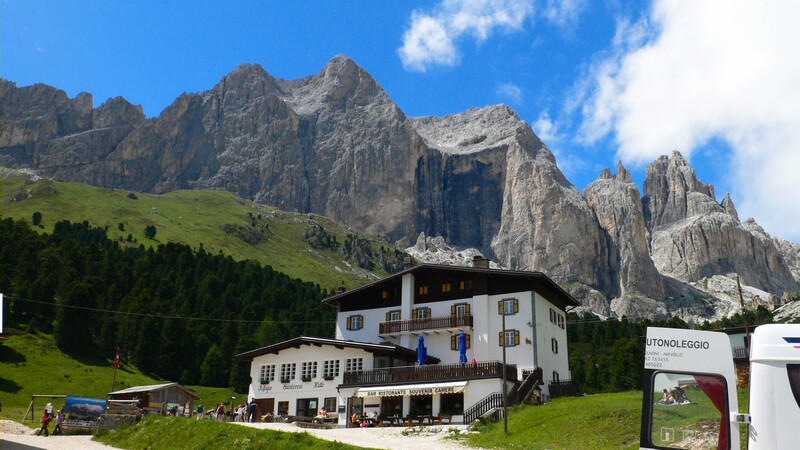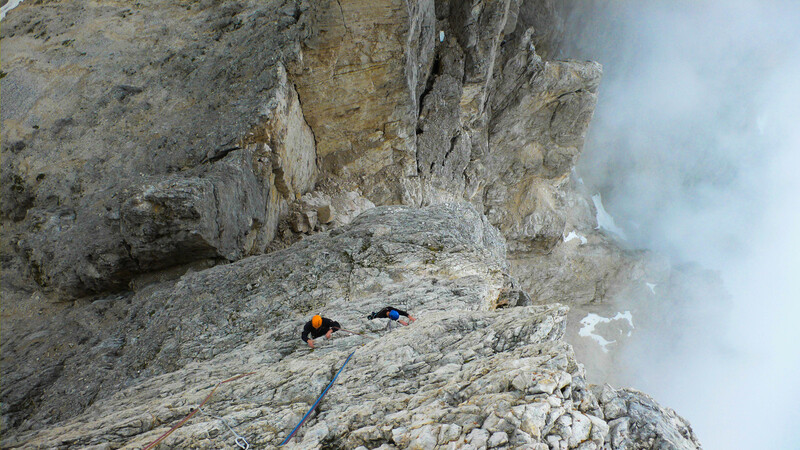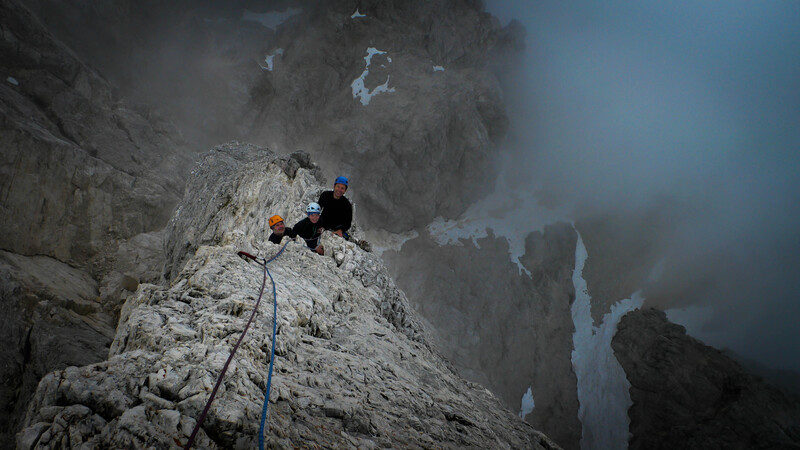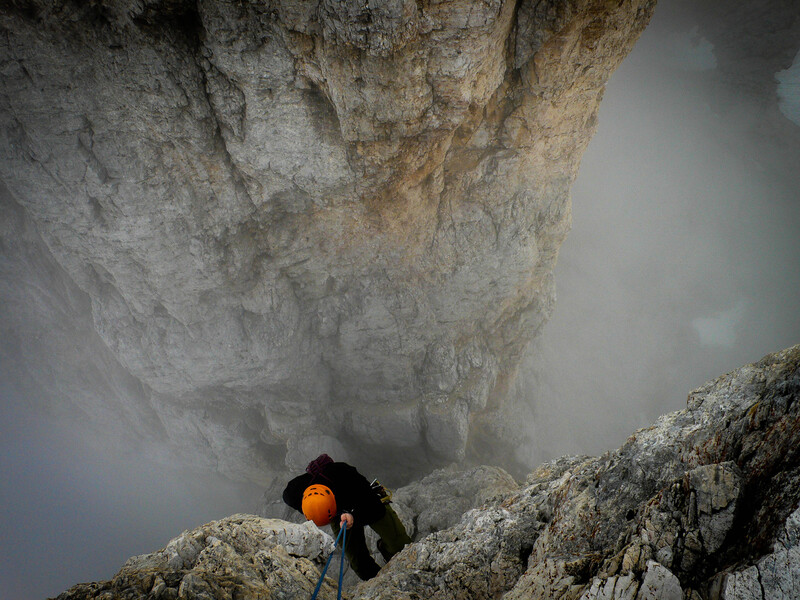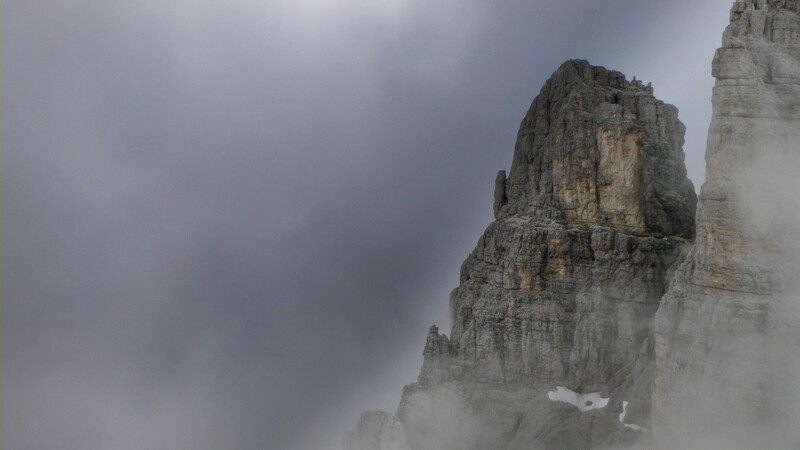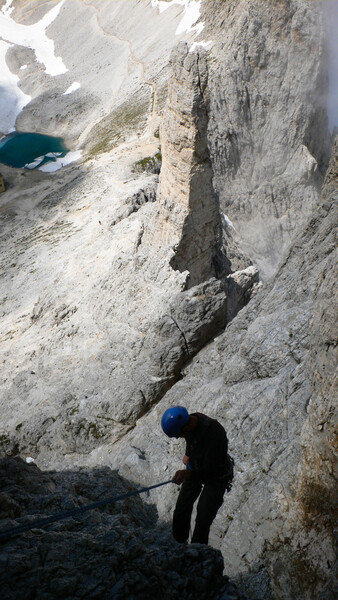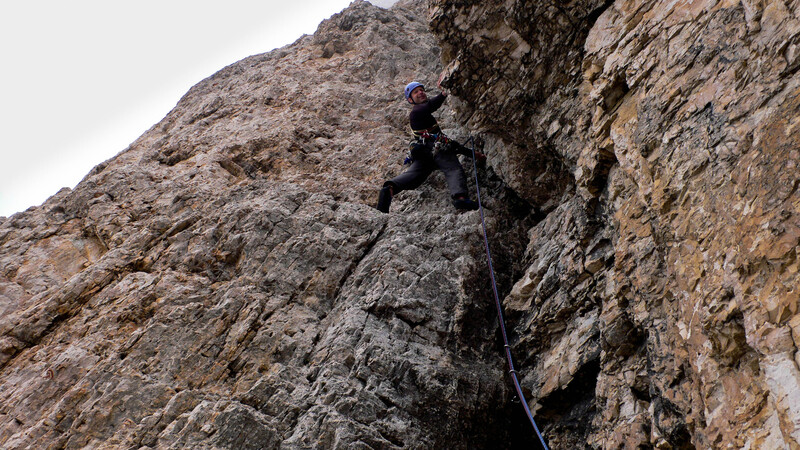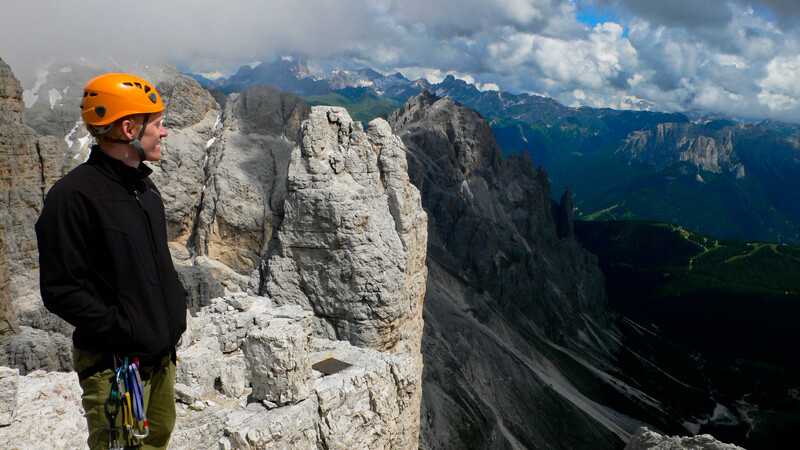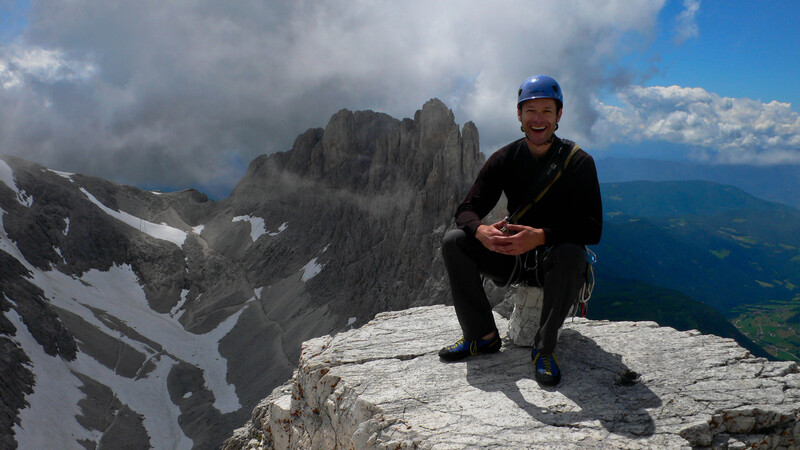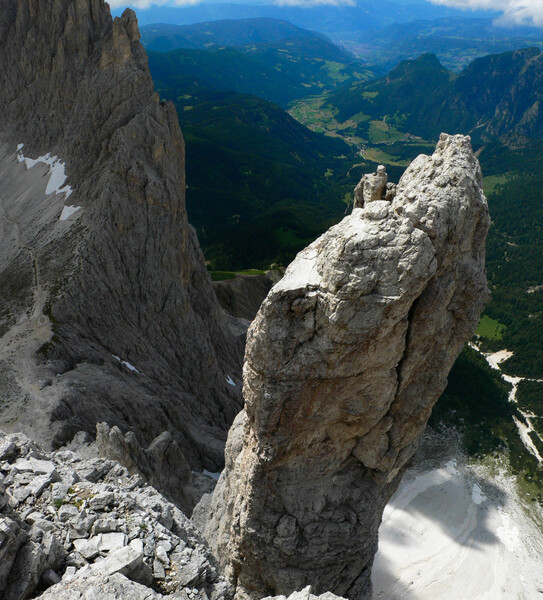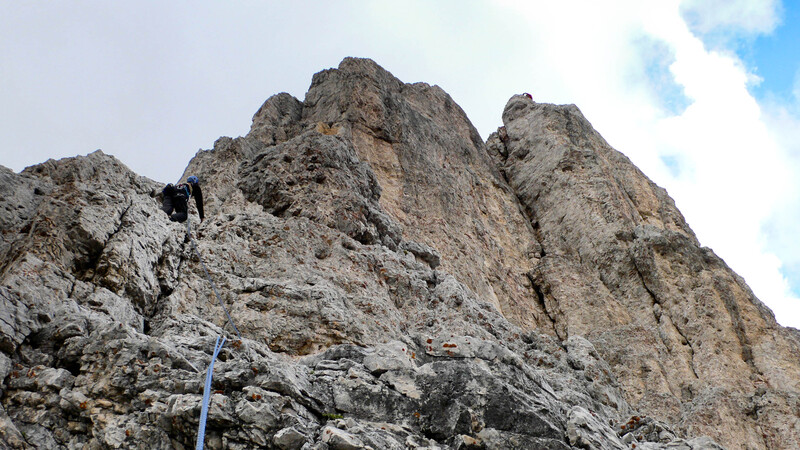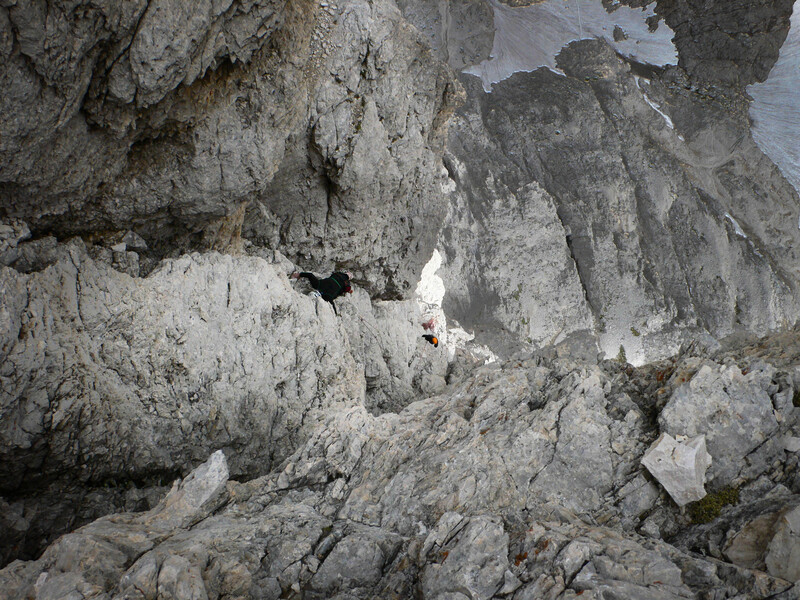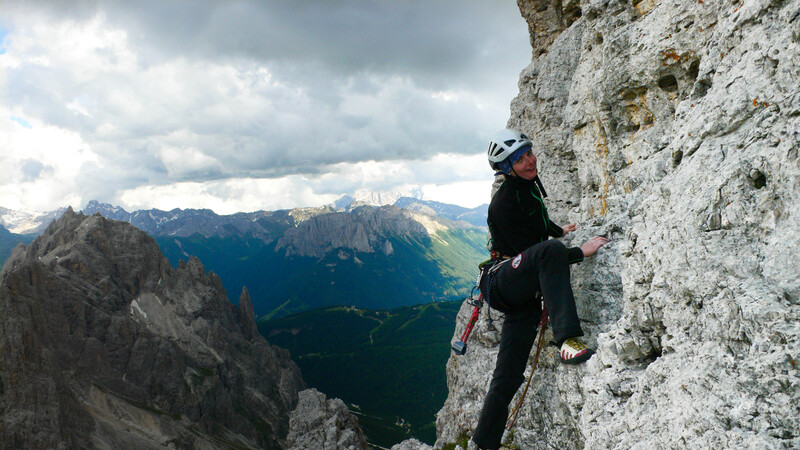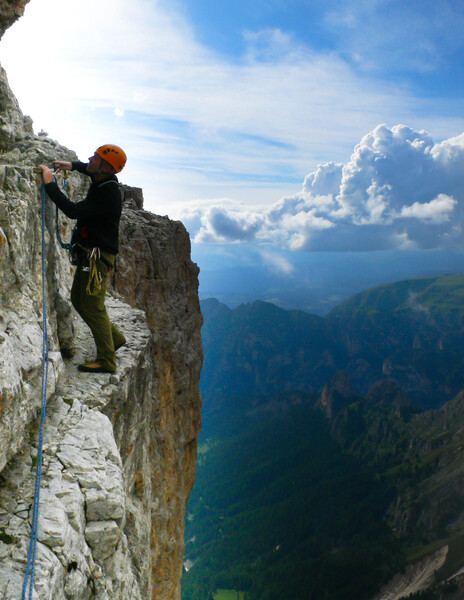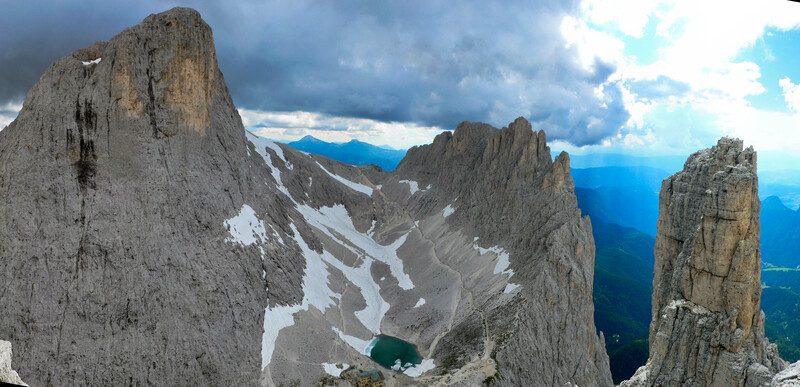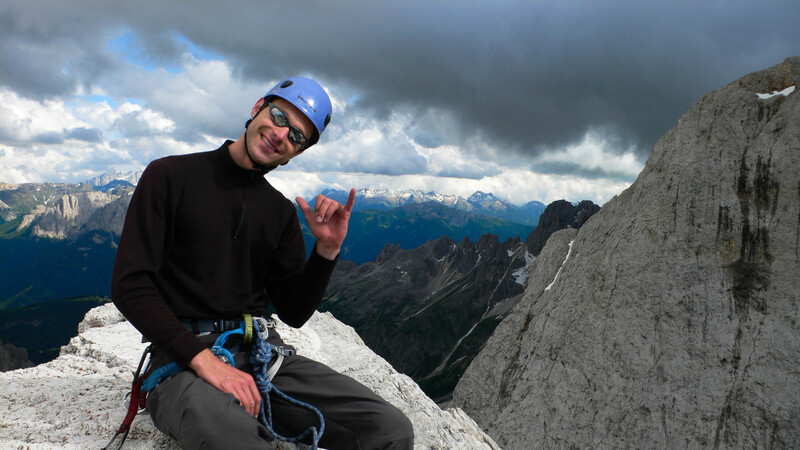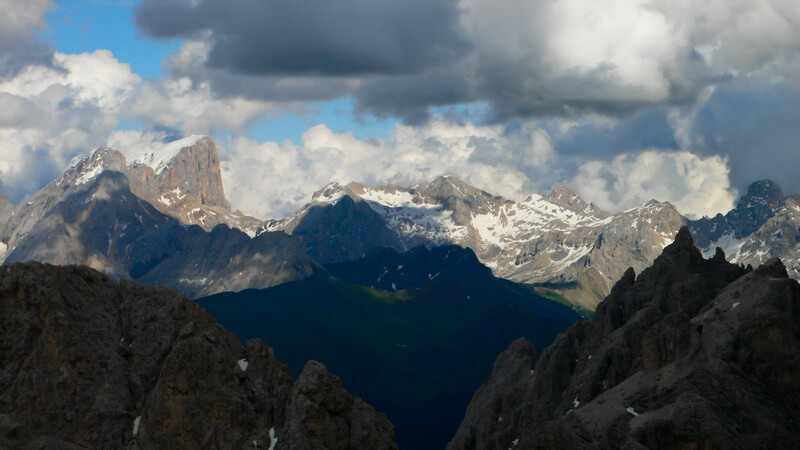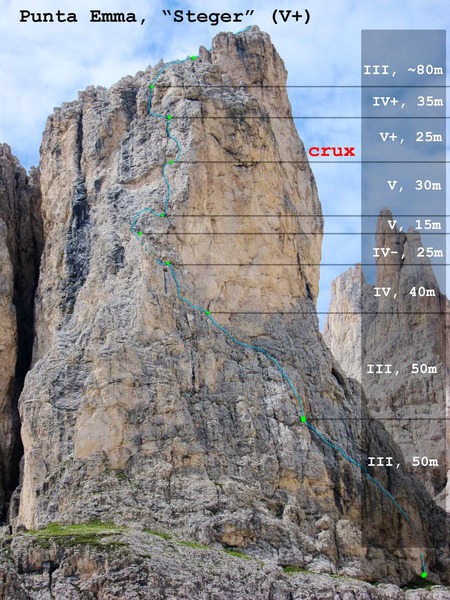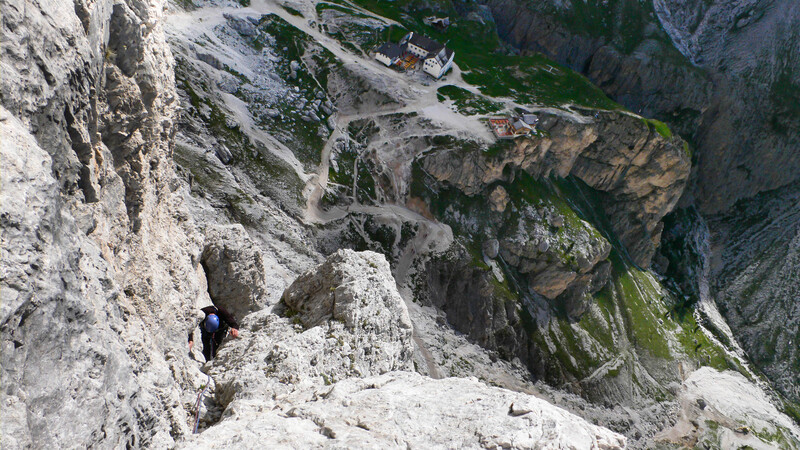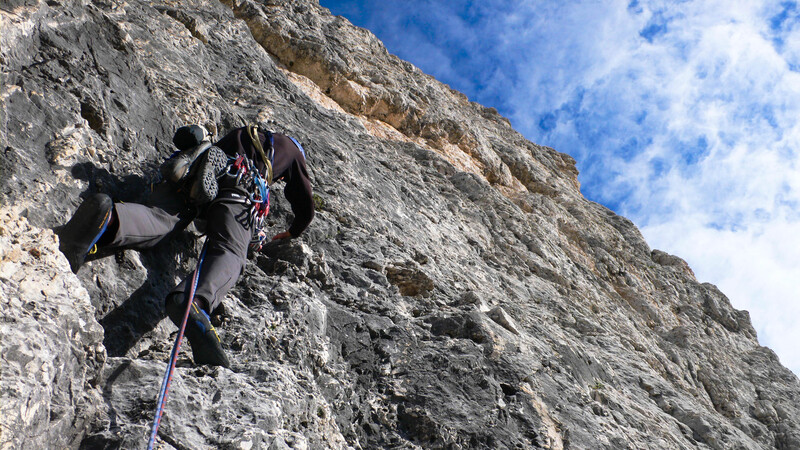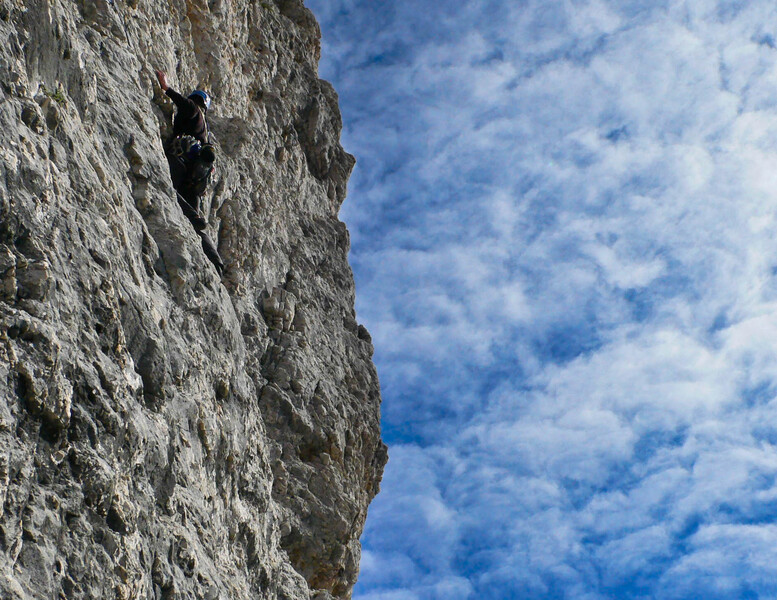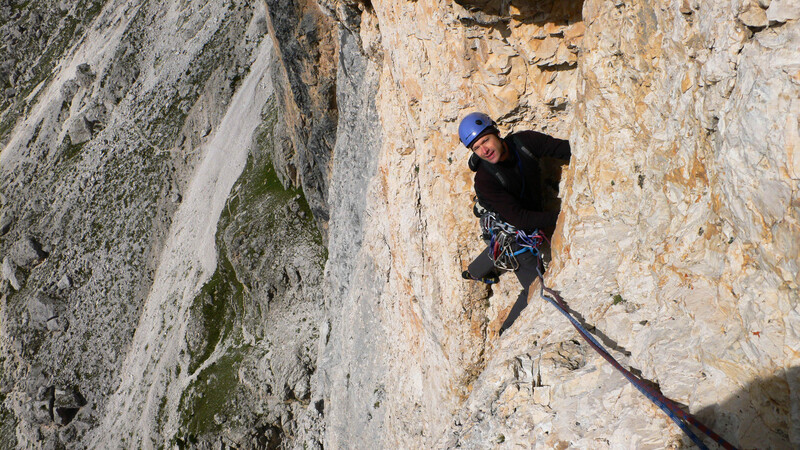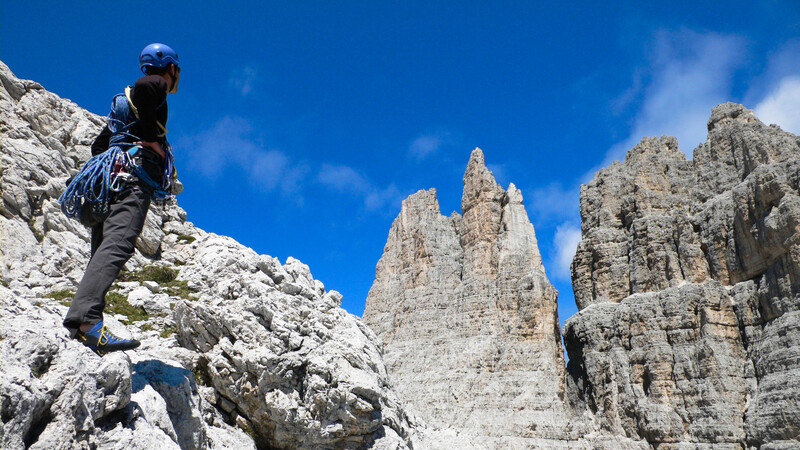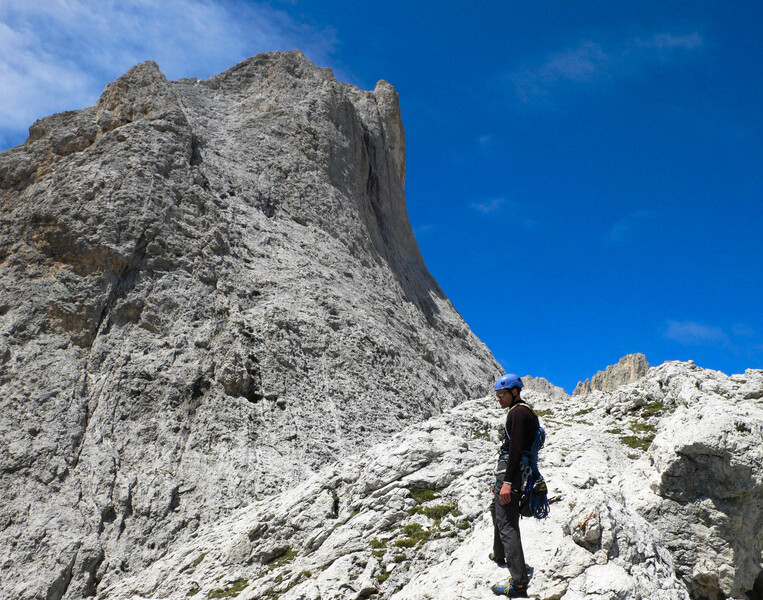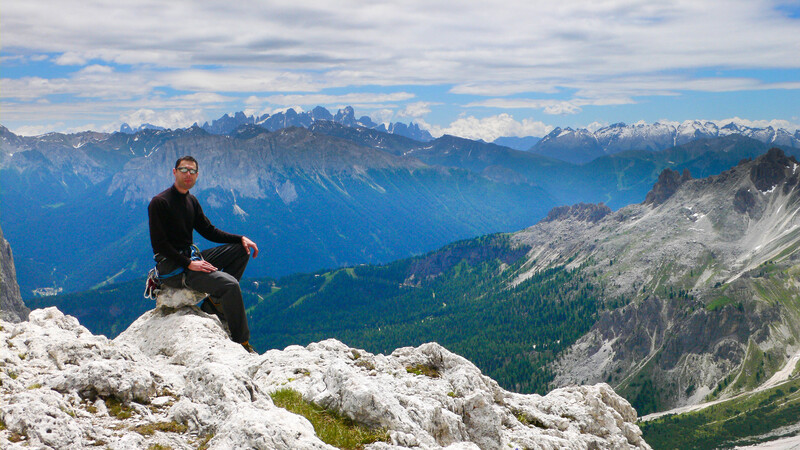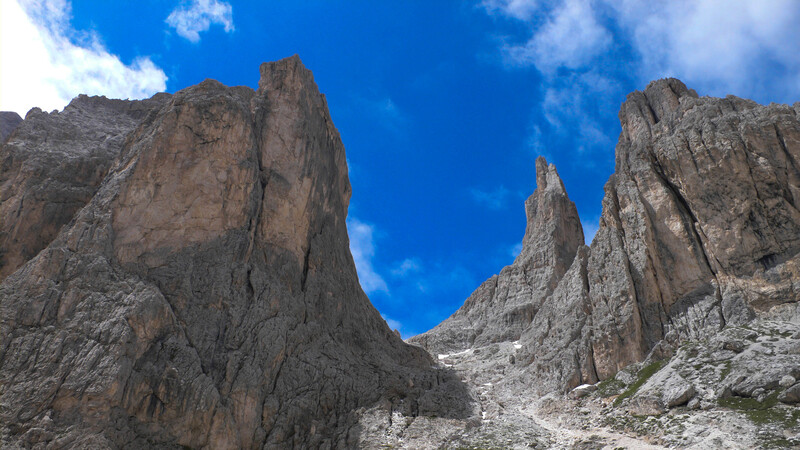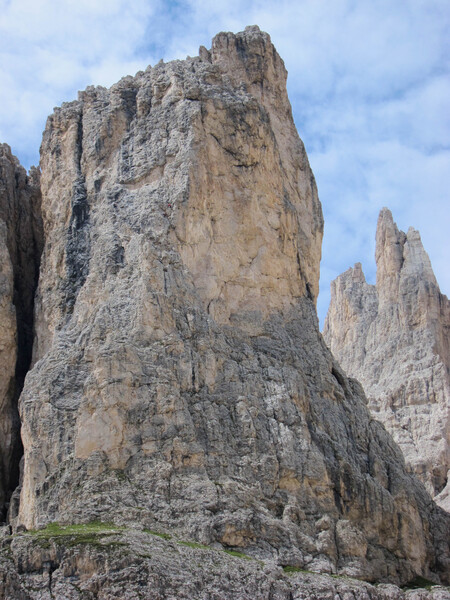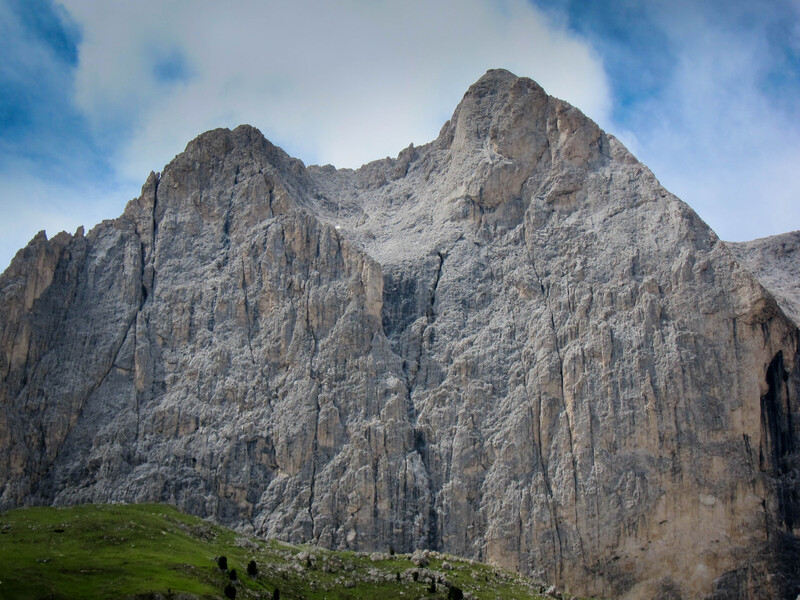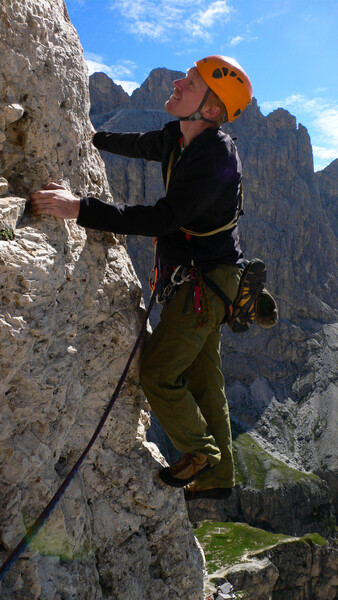The Vajolet Towers and Punta Emma
Friends: PeteLocation: Vajolet Towers
Elevation gain: 0m = 0m
Also posted on Summitpost.org here
A fellow American, Pete, and I visited the Rosengarten area of the Dolomites for a quick introduction to that beautiful group of spires. We had hoped to get three full days of climbing in, but bad weather effectively canceled the first day, and then the logistics of travel times and appointments caused us to shorten the last day considerably. But still, a day and a half of movement over good stone is nothing to sneeze at! We had a great time and planned many future ascents.
We arrived late in the touristic town of Pera, mistakenly believing that a bus taxi was still running to get us near the Vajolet Hut. Some frantic phone calls eventually found a bus taxi willing to drive up the road. He charged us each 15 euros, which is 3 times the normal price. As rain started to fall, we easily decided to pay instead of walking up a road for 2 hours.
A humorous event occurred next. Halfway up the road, we found 2 Germans and their van blocked by the closed road. They asked us to return with them to the parking lot and come back up. Somehow, we thought we could then pool our money and have a cheaper fare. The driver didn't really speak English or German that well (duh, he's in Italy after all. :)), so he didn't understand our thinking. Needless to say, we all payed 15 euros by the time we got to the road terminus an hour later...
After a drenching walk to the crowded hut, we ate dinner and attempted to dry our soaked clothing in a hilariously crowded drying room strewn with clotheslines. We planned to climb the three main Vajolet Towers by easy routes the next day, even if they were a bit wet. The forecast was "okay," but Saturday would be the best day.
By 9 am the next morning, we were at the base of the Delago Tower, intent on the spectacular and easy "Piaz Edge" (IV+). The waterfalls running down the faces the evening before left us little hope for dry rock, but the whole thing was perfectly dry, which surprised us.
One other party was on the tower this morning, a nice couple from the Munich area. We climbed along with them throughout the day. Here, on the first pitch, I was a bit impatient and decided to pass by on an independent line a bit left of the one Franzy (the nice girl) was taking. This meant I didn't get to use the nice pitons! No matter, there were good nut and cam placements along the 30 meter pitch, the only problem was that my fingers kept going numb in the morning chill. Here is a picture of Pete coming up in the blue helmet and our other friend from Munich on the left:
We continued up the ridge 4 more pitches to the summit. The most fun was when there was exposed climbing right on the crest. Sometimes the clouds would blow away and reveal stunning deeps far below. A few summit pictures, then down 6 ~20 meter rappels to our packs.
Next we headed up the "Fehrmann Corner" (IV+) of the Stabeler Tower. It was a bit hard to find the start, as we walked too far along the access ledge and found ourselves wandering around on an easy but confusing face. The couple from Munich joined us as we puzzled it out. Eventually Pete came to the insight that we were much too far to the right, and led me back down, around and up to exactly the right place to start. I hollered over to indicate we found the way, but we lost our friends temporarily.
Pete and I went two pitches, then he lucked out to lead the crux crack which was, alone among all the climbs of the day, dripping wet. Doh! We discussed the strategy, then he headed up the crack, careful and sure at every step. Following, I felt the section right level with and above a skirted roof were the most demanding. A good lead in trying conditions!
The Delago Tower from the summit of the Stabeler Tower.
An easier crack followed, then a short wall led to the fairly large summit. Pete found a nice natural rock chair. Good times...two down, one to go! Another 6 rappels and scrambling got us down.
Now for the Winkler Tower. Another party was seen on the imposing "Steger Route" (VI), which looks worth coming back for. We opted for the "Winkler Crack" (V, but we took an easier variant at IV+). Along with our friends from Munich, we scrambled over to the high ledge that accesses the route proper. We used a rope for a brief grade III step on the approach to the first pitch, then I investigated the Winkler Crack. It was quite strenuous. The day was late, and we needed to preserve energy for a big climb Saturday...I came down and led us on the easier variant. Looks good though...next time!
Friends coming up on the Winkler Tower
Franzy...
Ledges on descent...
Enjoyable climbing led to an especially enjoyable final pitch along a nice hand crack. Franzy and her friend were a couple of pitches below, and relying on us for route information. I hollered down some advice, then after a nice visit on the summit in better weather than the first two, we started down. The descent goes along the ascent route for a while. After some more information exchange, Pete and I headed off, scrambling around the corner to eventually reach the notch between the Stabeler and Winkler Towers. The obligatory rappels followed.
One interesting thing, we always used a single 50 meter rope for rappels instead of trying to combine with doubles. In certain situations this might have slowed us down, but often the rappels are at discontinuous locations or have features that could hang up the knot of a double rope rappel. It looked like we were at least as fast this way, and certainly had less coiling/uncoiling to do, along with less apprehension over the whole "stuck knot" issue. Pete and I are both pretty used to making fast and efficient rappels, a really useful skill.
We hiked down to another great dinner, and good views of the face we planned to climb the next day: Rosengartenspitze East Wall, via the "Steger" (18 pitches, grade VI-). But Pete tossed and turned all night, worried (justifiably!) about making it to Prague by noon on Sunday if we did such a big climb. In the morning, we immediately decided to do something smaller. Happily, the "Steger" route on Punta Emma fit the bill nicely.
I made a topo for "Steger"
Low on the Steger Route.
We climbed the first two easy pitches in gloves against the cold (well, me in socks!). We came into the sun and enjoyed several hours of great climbing, with three sustained pitches of gray and yellow Dolomiti face climbing at it's center. This was really excellent, and the warm sun made up for many rather chilly hours the day before. The clarity in the air was magnificent. Some scrambling brought us to the summit, then a rather intimidating long rappel got us to a snow-choked gully. We picked our way down, and soon were back at the car, enjoying a good pizza lunch below the "Rotwand" on the road to Bolzano.
Our playground....
The Steger Route on Punta Emma. Some climbers are visible.
It was great to climb with Pete for the first time, looking forward to awesome future adventures!
A future adventure...
Detailed pitch description:
Delago Tower, "Piaz Edge" (IV+)
P1: II, 30 m. Scrambling up a ledge to reach the ridgecrest on the left.
P2: IV+, 30 m. Enjoyable, solid climbing up a face with cracks to a piton belay on the crest. Well protected with pins, though we climbed a variant on the left with natural protection.
P3: IV, 25 m. On the ridge crest, beautiful exposure and solid (albeit polished) rock.
P4: IV, 25 m. Climbing an enjoyable dihedral passed fixed pins.
P5: IV-, 25 m. Leave the crest, going right a bit, then coming back.
P6: III, 25 m. Climb easily along the flattening crest to the summit.
Descent via 6 straightforward short rappels.
Stabeler Tower, Fermann Corner (IV+)
P1: II, 30 m. Scrambling up a face just left of a steep edge to a two piton belay stance.
P2: IV-, 25 m. Follow a slab to a short vertical step to the base of a corner on the right.
P3: IV, 30 m. Climb a nice corner up to a narrow band below an overhang.
P4: IV+, 22 m. Climb a nice crack on the left of the belay to escape the overhang. The crux pitch, we found it very wet.
P5: IV-, 15 m. A short scramble to avoid an overhang via steps on the right.
P6: IV or IV-, 30 m. We avoided the steep crack left of the belay by a face variation even further left, later rejoining the pleasantly vertical crack at a chockstone (protectable). Belay at a notch where the normal route intersects.
P7: IV-, 10 m. Short step, probably should be combined with P6.
Descend via rappels and scrambling.
Winkler Tower, Winkler Crack (IV+)
P1-3: Scrambled the first two pitches of the Stabeler Normal route (III), then a brief move of grade III along a ledge.
P4: IV+ 26 meters. Nice face climbing to the right of the official "Winkler Crack," later rejoined higher up.
P5: III+, 30 m. Easy gully to a strange rightward move and a crux exit onto a ledge.
P6: IV, 17 m. Up an awkward crack which eases after two pitons to a belay at a notch.
P7: III+, 20 m. Up a face and corner to a belay below a crack.
P8: IV-, 20 m. A very nice crack pitch.
P9: II, 20 m. For us, this easy terrain was simul-climbed with P8.
Descended via rappels and some short-roped climbing (III).
Punta Emma, "Steger" Route (V+).
P1: III+, 45 m. Easy climbing along a natural ramp.
P2: III, 45 meter. Continue along the ramp to it's terminus at a grassy point with many belay pitons. Confident climbers might begin roped travel here.
P3: IV, 45 m. Climb a nice gray dihedral/crack to a piton belay at a yellow notch on the (apparent) ridge crest.
P4: IV-, 25 m. Traverse left from the belay on a ledge, then up a gray chimney/crack passed a piton (I missed it).
P5: V, 15 m. Exposed face climbing, going a few meters up then right and eventually down at a "yellow niche." The crux is a few face moves before climbing down passed the niche. Belay in a shallow gully right of the niche.
P6: V, 30 m. Really fun face climbing, well-protected by pitons. Generally straight up, though a bit left and up again at the halfway point to end up in a yellow niche beneath an overhang. The crux is escaping this niche on the right with slabby footholds. A well-fixed nut protected those moves nicely!
P7: V+, 25 m. Our topo describes the crux of this pitch as "continuously difficult." It was definitely continuously enjoyable. Step right to avoid an overhang, then continue out of sight of your belayer for the whole pitch, up a steep face festooned with holds. Finish via an obvious crack to a hard-to-see belay station. I missed it and only found it later thanks to some cigarette butts!
Me heading out for the crux...
P8: IV+, 35 m. Traverse left then up a very nice gray corner crack. Protects well with cams and the occasional fixed pin.
P9: III, 50 m. Scramble up gullies and crests, with the best climbing on crests (solid).
P10: III, 50 m. Continue as before. We combined P9 and P10 with simul-climbing.
P11: III, 50 m. A short vertical step (III) accesses solid but low-angle scrambling terrain. We soloed this pitch to the summit.
Descend via downclimbing, a spot of belaying (III), a long (25 meter) rappel, then more downclimbing (II).
